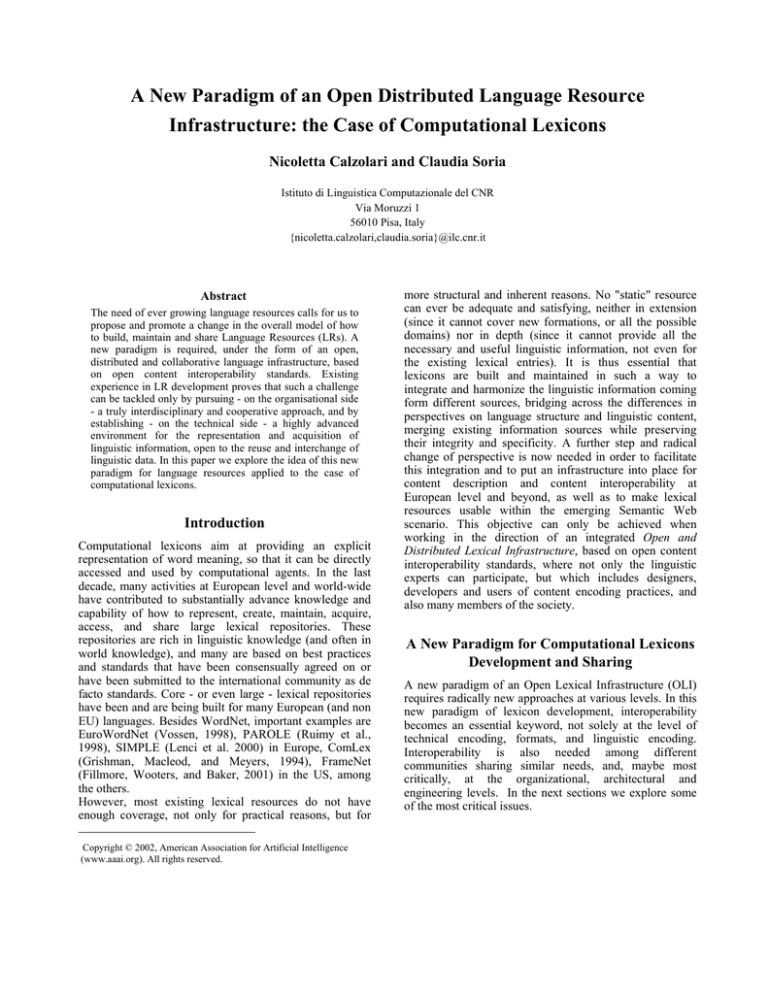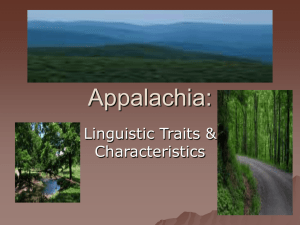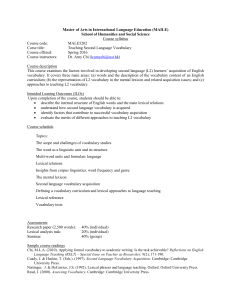
A New Paradigm of an Open Distributed Language Resource
Infrastructure: the Case of Computational Lexicons
Nicoletta Calzolari and Claudia Soria
Istituto di Linguistica Computazionale del CNR
Via Moruzzi 1
56010 Pisa, Italy
{nicoletta.calzolari,claudia.soria}@ilc.cnr.it
Abstract
The need of ever growing language resources calls for us to
propose and promote a change in the overall model of how
to build, maintain and share Language Resources (LRs). A
new paradigm is required, under the form of an open,
distributed and collaborative language infrastructure, based
on open content interoperability standards. Existing
experience in LR development proves that such a challenge
can be tackled only by pursuing - on the organisational side
- a truly interdisciplinary and cooperative approach, and by
establishing - on the technical side - a highly advanced
environment for the representation and acquisition of
linguistic information, open to the reuse and interchange of
linguistic data. In this paper we explore the idea of this new
paradigm for language resources applied to the case of
computational lexicons.
Introduction
Computational lexicons aim at providing an explicit
representation of word meaning, so that it can be directly
accessed and used by computational agents. In the last
decade, many activities at European level and world-wide
have contributed to substantially advance knowledge and
capability of how to represent, create, maintain, acquire,
access, and share large lexical repositories. These
repositories are rich in linguistic knowledge (and often in
world knowledge), and many are based on best practices
and standards that have been consensually agreed on or
have been submitted to the international community as de
facto standards. Core - or even large - lexical repositories
have been and are being built for many European (and non
EU) languages. Besides WordNet, important examples are
EuroWordNet (Vossen, 1998), PAROLE (Ruimy et al.,
1998), SIMPLE (Lenci et al. 2000) in Europe, ComLex
(Grishman, Macleod, and Meyers, 1994), FrameNet
(Fillmore, Wooters, and Baker, 2001) in the US, among
the others.
However, most existing lexical resources do not have
enough coverage, not only for practical reasons, but for
Copyright © 2002, American Association for Artificial Intelligence
(www.aaai.org). All rights reserved.
more structural and inherent reasons. No "static" resource
can ever be adequate and satisfying, neither in extension
(since it cannot cover new formations, or all the possible
domains) nor in depth (since it cannot provide all the
necessary and useful linguistic information, not even for
the existing lexical entries). It is thus essential that
lexicons are built and maintained in such a way to
integrate and harmonize the linguistic information coming
form different sources, bridging across the differences in
perspectives on language structure and linguistic content,
merging existing information sources while preserving
their integrity and specificity. A further step and radical
change of perspective is now needed in order to facilitate
this integration and to put an infrastructure into place for
content description and content interoperability at
European level and beyond, as well as to make lexical
resources usable within the emerging Semantic Web
scenario. This objective can only be achieved when
working in the direction of an integrated Open and
Distributed Lexical Infrastructure, based on open content
interoperability standards, where not only the linguistic
experts can participate, but which includes designers,
developers and users of content encoding practices, and
also many members of the society.
A New Paradigm for Computational Lexicons
Development and Sharing
A new paradigm of an Open Lexical Infrastructure (OLI)
requires radically new approaches at various levels. In this
new paradigm of lexicon development, interoperability
becomes an essential keyword, not solely at the level of
technical encoding, formats, and linguistic encoding.
Interoperability is also needed among different
communities sharing similar needs, and, maybe most
critically, at the organizational, architectural and
engineering levels. In the next sections we explore some
of the most critical issues.
Architectural, Representational and Content
Issues
Standardization and Lexical Modelling. For the
resources to be multilingual and shareable, the
harmonization task between the different resources
becomes a very important and extensive one. The
standardization effort must involve the extension and
integration of existing and emerging open lexical and
terminological standards and best practices such as
EAGLES (Sanfilippo et al. 1999), ISLE (Calzolari, Lenci,
and Zampolli 2001), TEI, OLIF, Martif (ISO 12200), Data
Categories (ISO 12620), ISO/TC37/SC4. Initiatives
towards the creation of lexical metadata such as IMDI,
Dublin Core and OLAC must be taken into account. It is
already clear that there is a great convergence among these
initiatives, and synergies can be "easily" created. For
example, the Computational Lexicon Working Group of
ISLE has defined a general schema for the encoding of
multilingual lexical information, the MILE (Multilingual
ISLE Lexical Entry, Calzolari et al. 2003) . This has to be
intended as a meta-entry, acting as a common
representational layer for multilingual lexical resources.
Main related concepts are the following: The MILE
Lexical Data Categories provide the lexical objects (such
as syntactic and semantic features, semantic relations,
syntactic constructions, predicates and arguments etc.) that
are the basic components of MILE-conformant lexical
entries. Lexical Data Categories are organized in a
hierarchy and defined using RDF schema to formalize
their properties and make their “semantics” explicit (Ide,
Lenci, and Calzolari 2003). The MILE Shared Lexical
Objects instantiate the MILE Lexical Data Categories, to
be used to build in an easy and straightforward way lexical
entries. These include main syntactic constructions, basic
operations and conditions to establish multilingual links,
macro-semantic objects, such as lexical conceptual
templates acting as general constraints for the encoding of
semantic units.
The MILE Entry Skeleton, formalized as an XML DTD, is
an Entity Relationship model that defines the general
constraints for the construction of “ideal” multilingual
entries, as well as the grammar to build the whole array of
lexical elements needed for a given lexical description. A
core set of consensual basic lexical notions can be
implemented as basic shared lexical “objects”.
Lexical data categories and objects will be identified by an
URI and will act as a common resource for lexical
representation, to be in turn described by RDF metadata.
They can be seen as a step in the direction of simplifying
and
improving
the usability of the MILE
recommendations, and of opening lexicon building to a
cooperative effort. Lexicon (or applications) developers
will be encouraged to use these lexical objects to build and
target lexical data at a high level of abstraction, i.e. for the
description, creation, management, and delivery of their
resources, therefore creating semantic interoperability. A
test on the potentialities of MILE as a standard
environment for computational lexicons is described in
(Bertagna et al. 2004).
Lexicon Integration and Interoperability. The model of
open data categories will foster language resources
integration and interoperability, through links to these
common standards. New objects can be progressively
created and linked to the core set.
We foresee an increasing number of well-defined
linguistic data categories and lexical objects stored in open
and standardised repositories which will be used by users
to define their own structures within an open lexical
framework. It is this re-usage of shared linguistic objects
which will link new contents to the already existing lexical
objects, while enabling shareability of distributed lexicon
portions. The design of an abstract model of lexicon
architecture will ensure a flexible model while working
with a core set of lexical data categories. It will guarantee
freedom for the user to add or change objects if that is
deemed necessary, will provide an evaluation protocol for
the core standard lexical data categories, and will require
verification methods for the integration of new objects. We
are currently working towards this end in two closely
related frameworks, namely the Working Group 4 on
Lexical Standards of ISO/TC 37/SC 4 and the recently
approved EU project LIRICS.
From Static to Dynamic Lexicons. The promotion of a
change of perspective on lexicons as static resources
towards dynamic entities, whose content is co-determined
by automatically acquired linguistic information from text
corpora and from the web, is deemed essential. We stress
the need of using (semi-)automatic or machine aided
methods wherever possible in resource work. Semantic
Web initiatives are also focusing on the building of
ontological representations from texts, and in this respect
show a large amount of conceptual overlap with the notion
of a dynamic lexicon. In automating the information
extraction process, lexical resources are a fundamental
piece, and acquisition may require cycles of adjustments in
the lexical modelling. The acquisition tools must be able to
increase the repository with new words/terms, possibly
their definitions, domain, etc., from digital material, to
learn concepts from text – including automatic multilingual thesaurus building, and to tailor resources to
specific needs. This implies, for the machine learning
community, developing new and stronger algorithmic
methodologies to model textual statistics, and integrating
them with traditional NLP tools. In a web-service oriented
implementation of this idea, agents will look for examples,
identify uses in monolingual/multilingual web texts for
glossary creation. This will ensure also virtual links
between lexicons and examples (corpus/web samples,
image samples, clips and videos, etc.), pushing towards
new and innovative types of lexicons, i.e. a sort of
“example based living lexicons”, linguistic objects that
participate of properties of both lexicons and corpora.
A Cooperative Model. This vision will pave the way to
the realisation of a common platform for interoperability
between different fields of linguistic activity - such as
lexicology, lexicography, terminology - and Semantic Web
development. The platform will provide a flexible common
environment not only for linguists, terminologists and
ontologists, but also for content providers and content
management software vendors. The lexicons may be
distributed, i.e. different building blocks may reside at
different locations on the web and be linked by URLs.
This is strictly related to the Semantic Web standards (with
RDF metadata to describe lexicon data categories), and
will enable users to share lexicons and collaborate on parts
of them. Overall, the lexicons will perform the bridging
function
between
documents
and
conceptual
categorisation. The descriptive framework and the tools
must be tailored to the needs of the creation of both
general vocabularies and terminological repositories for
different worlds and domains. The common conceptual
model within the envisaged architecture will ensure
content interoperability between texts, multimodal
documents, lexicons and ontologies.
Organizational Issues
Integration of Communities. The effort of making
millions of “words” available for dozens of languages is
something that no individual or small group is able to
afford. It is already proved by a number of EU projects
that lexicon building and maintenance can be achieved in a
cooperative way. We claim that the field of computational
lexicons is mature enough to broaden and open the concept
of cooperative effort to a much larger set of communities,
so that lexicon creation, updating and maintenance will be
no longer only a lexicographers' task, but will involve
broad groups of experts, and - why not? – also “nonexperts” and the general public. Lexicons undoubtedly
form an essential component and a building block of great
impact to make the vision of a pervasive Information
Infrastructure and of the Semantic Web a reality. The
availability of large computational lexicons is an essential
prerequisite to the twofold challenge of digital content and
multilinguality. Semantic Web developers will need
repositories of words and terms, as well as knowledge
about their relations within language use and ontological
classification. However, the cost of adding structured and
machine-understandable lexical information can be again a
bottleneck, i.e. one of the factors that delay semantic web
full deployment. Unfortunately, linguists alone will not be
able to solve this. To achieve a real break-through, a
radical shift in the lexical paradigm - whereby many
participants add linguistic content descriptions in an open
distributed lexical framework – is required to make the
Web usable.
International
Cooperation
and
Organization.
International cooperation will become certainly the most
important factor for the overall field of language resources
– and consequently of computational lexicons - in the next
years. A report produced by ELDA presents an analysis of
several organisational frameworks, focussing on funding
and organisational procedures for providing LRs (Calzolari
et al. 2004). The pre-requisites to be addressed for the
production of interoperable LRs in a cooperative
framework belong to different layers: technical
(specifications), validation (quality assessment), legal,
commercial. In order to fill the gaps in terms of LRs,
cooperation on all combined - organisational, funding,
technical and commercial - issues appears to be necessary.
To strengthen such a cooperation, there is no doubt that a
supra-national effort in coordinating this cooperation is
required.
Validation and Quality Control Activities. Quality
control and validation become very important issues to
ensure the quality of cooperatively built resources. There is
obviously always a greater danger of unreliability in
semiautomatic harvesting and dynamic extension of the
lexicon. The opportunity that everyone could access
existing data to put in new information, requires careful
consideration on how quality can be ensured. Verification
methods are required for the integration of new lexical data
categories, and validation protocols need to be designed
and adopted (e.g. a mechanism of certificates of validity
can be designed, according to different criteria).
Market-related Issues, Access and Pricing. Access and
pricing policies must be carefully considered and designed,
and may be different for different uses and users types.
Access policy requires also study of national versions of
copyright law. A business model has to be studied, based
on the idea of web-based services.
Conclusions
We claim that it is feasible and timely - and indeed
critically needed - to set up a very large world-wide
initiative, within which a large group of lexicon
experts/providers is a core component. This initiative must
build prominently on existing or future (possibly national)
lexical initiatives and integrate the human R&D resources
along this dimension. However, an essential aspect to
ensure an integrated basis is to enhance the interchange
and cooperation among many communities that act now
separately, such as Language Resources developers,
Terminology, Semantic Web and Ontology experts,
content providers. This is the challenge for the next years,
for a usable and useful lexical scenario in the global
network.
References
Bertagna, F., Lenci, A., Monachini, M., and Calzolari, N. 2004.
“Content Interoperability of Lexical Resources : Open Issues and
MILE Perspectives”. In Proceedings of the Fourth International
Conference on Language Resources and Evaluation, 131-134.
Paris, The European Language Resources Association (ELRA).
Calzolari, N., Lenci, A., and Zampolli, A. 2001. International
Standards for Multilingual Resource Sharing: the ISLE
Computational Lexicon Working Group. In Proceedings of the
ACL-EACL Workshop on Sharing Tools and Resources, 71-78.
Toulouse, CNRS.
Calzolari, N., Bertagna, F., Lenci, A., and Monachini, M. eds.
2003. Standards and Best Practice for Multilingual
Computational Lexicons. MILE (the Multilingual ISLE Lexical
Entry). ISLE CLWG Deliverable D2.2 & 3.2. Pisa (Also URL
http://www.ilc.cnr.it/EAGLES96/isle/clwg_doc/ISLE_D2.2D3.2.zip).
Fillmore, C.J., Wooters, C., and Baker, C.F. 2001. Building a
Large Lexical Databank which Provides Deep Semantics. In
Proceedings of the Pacific Asian Conference on Language,
Information and Computation, Hong Kong.
Grishman, R., Macleod, C., and Meyers, A. 1994. COMLEX
Syntax: Building a Computational Lexicon. In Proceedings of
Coling 1994, Kyoto.
Ide, N., Lenci, A., and Calzolari, N. 2003. RDF Instantiation of
ISLE/MILE Lexical Entries. In Proceedings of the ACL 2003
Workshop on Linguistic Annotation: Getting the Model Right, 2534., Sapporo (Japan), ACL.
Lenci, A., Bel, N., Busa, F., Calzolari, N., Gola, E., Monachini,
M., Ogonowsky, A., Peters, I., Peters, W., Ruimy, N., Villegas,
M., and Zampolli, A. 2000. SIMPLE: A General Framework for
the Development of Multilingual Lexicons. International Journal
of Lexicography, 13(4):249-263.
Ruimy, N., Corazzari, O., Gola, E., Spanu, A., Calzolari, N., and
Zampolli, A. 1998. The European LE-PAROLE Project: the
Italian Syntactic Lexicon. In Proceedings of the First
International Conference on Language Resources and
Evaluation, 241-248. Paris, The European Language Resources
Association (ELRA).
Ruimy, N., Monachini, M., Gola, E., Calzolari, N., Del
Fiorentino, M.C., Ulivieri, M., and Rossi, S. 2003. A
computational semantic lexicon of Italian: SIMPLE. In A.
Zampolli, N. Calzolari, and Cignoni, L. eds., Computational
Linguistics in Pisa – Linguistica Computazionale a Pisa. Special
Issue of Linguistica Computazionale. Pisa, IEPI, 821-864.
Sanfilippo, A., Calzolari, N., Ananiadou, S., Gaizauskas, R.,
Saint-Dizier, P., and Vossen, P. eds. 1999. EAGLES
Recommendations on Semantic Encoding. EAGLES LE3-4244
Final Report. (Also URL: http://www.ilc.cnr.it/Eagles96/rep2).
Vossen, P. 1998. Introduction to EuroWordNet. Computers and
the Humanities 32:73-89.








